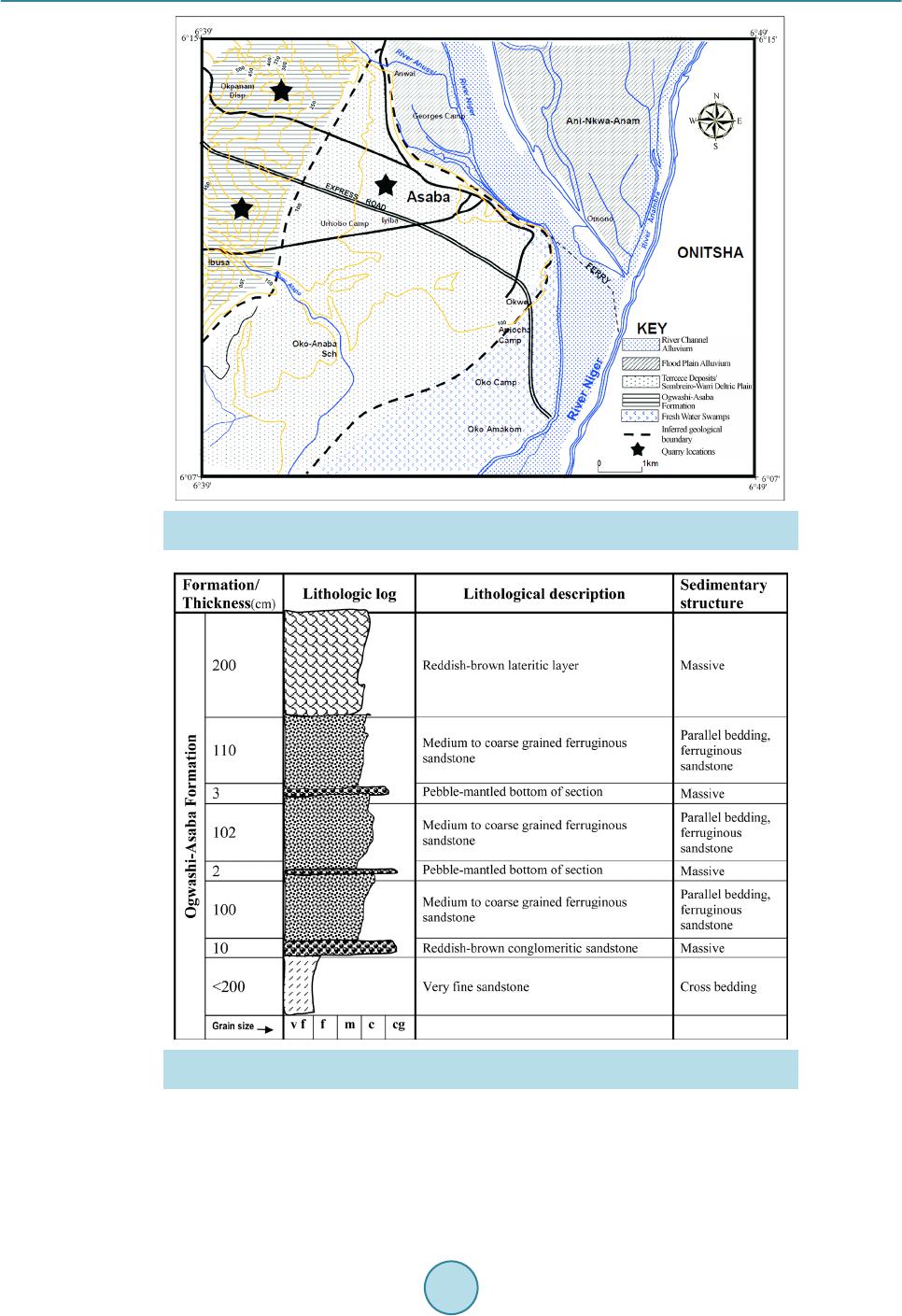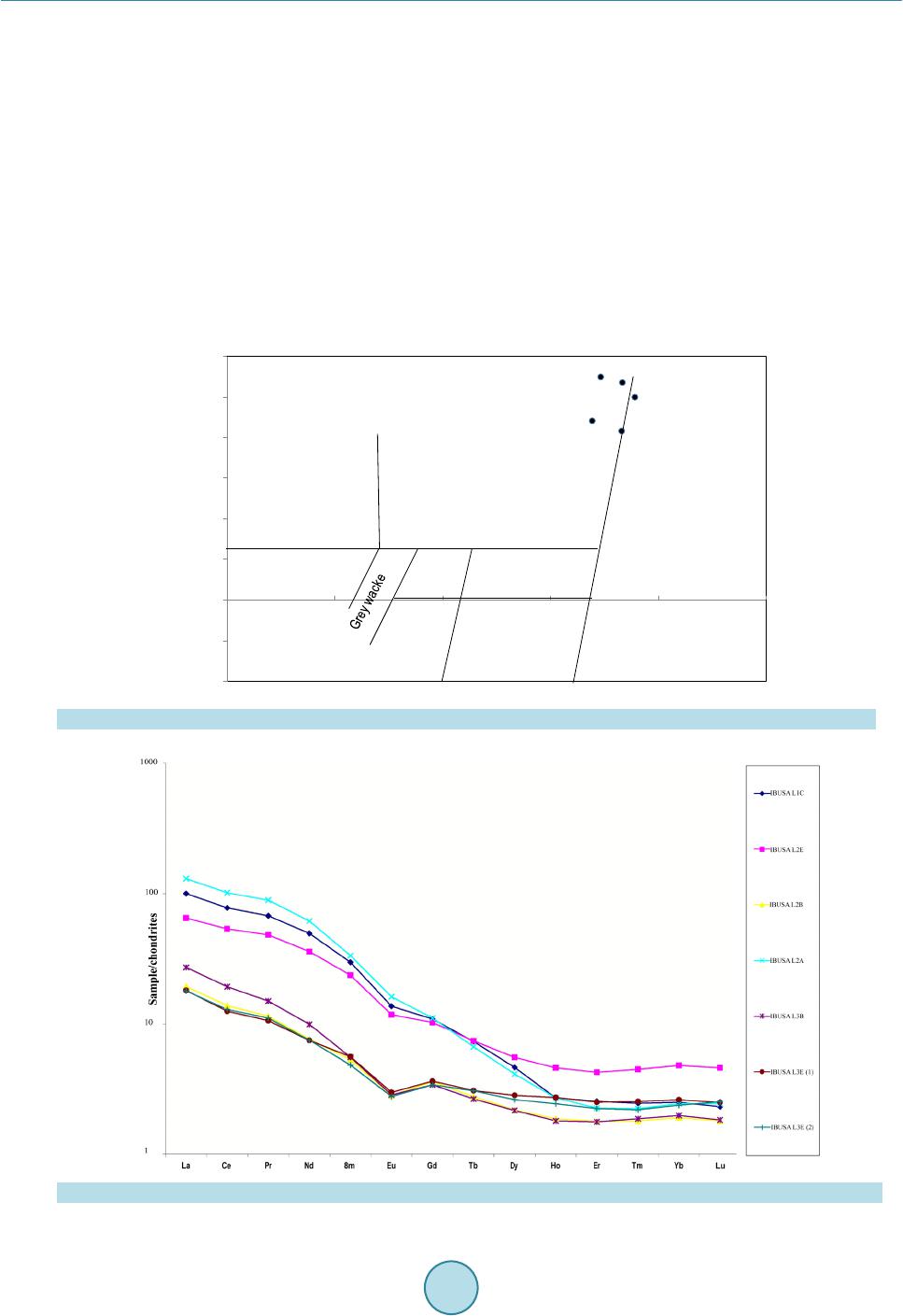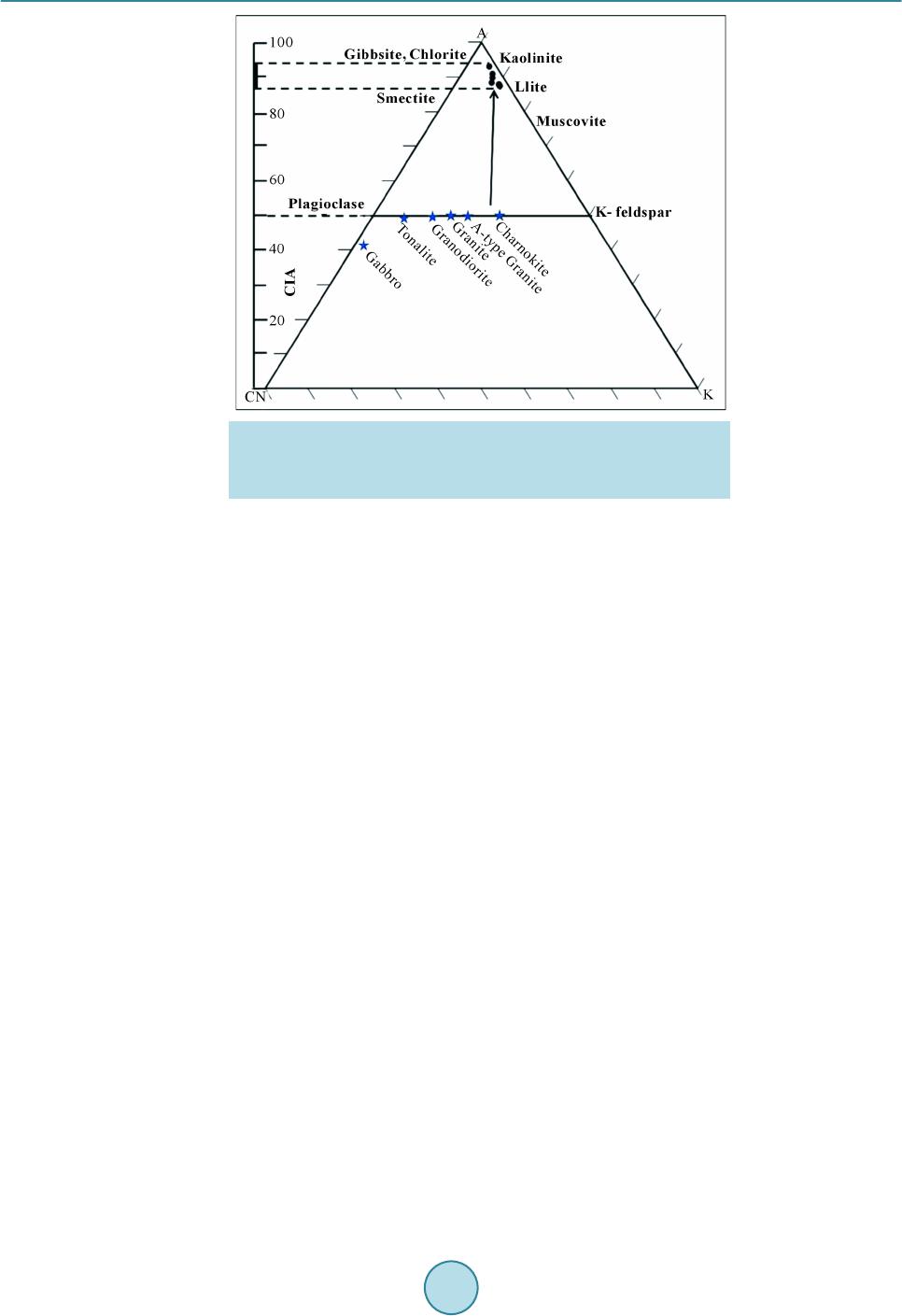 Open Journal of Geology, 2015, 5, 562-576 Published Online August 2015 in SciRes. http://www.scirp.org/journal/ojg http://dx.doi.org/10.4236/ojg.2015.58051 How to cite this paper: Ejeh, O.I., Akpoborie, I.A. and Etobro, A.A.I (2015) Heavy Minerals and Geochemical Characteristics of Sandstones as Indices of Provenance and Source Area Tectonics of the Ogwashi-Asaba Formation, Niger Delta Basin. Open Journal of Geology, 5, 562-576. http://dx.doi.org/10.4236/ojg.2015.58051 Heavy Minerals and Geochemical Characteristics of Sandstones as Indices of Provenance and Source Area Tectonics of the Ogwashi-Asaba Formation, Niger Delta Basin O. Innocent Ejeh, I. Anthony Akpoborie, A. A. Israel Etobro Department of Geology, Delta State University, Abraka, Nigeria Email: tony.akpoborie@gmail.com Received 8 July 2015; accepted 23 August 2015; published 26 August 2015 Copyright © 2015 by authors and Scientific Research Publishing Inc. This work is licensed under the Creative Commons Attribution International License (CC BY). http://creativecommons.org/licenses/by/4.0/ Abstract Heavy mineral petrographic and geochemical compositions (major and trace/rare earth elements) of sandstones obtained from the Oligocene-Miocene Ogw ashi -Asaba Formation, Niger Delta were studied to determine their provenance, source area weathering conditions and tectonic setting. The heavy mineral suite (opaque minerals, zircon, tourmaline, and rutile) revealed that the sand- stones are mineralogically mature and implied rapid disintegration and chemical decomposition of sediments mostly of recycled orogen. The sandstones were geochemically classified as Fe-sand and partly quartz arenitic. Chemical Index of Alteration and Chemical Index of Weathering values of 89.92% and 91.87% respectively suggest that the source region was predominantly felsic and was subjected to intense chemical weathering probably under tropical palaeoclimatic conditions with abundant rainfall that enhanced sediment recycling. Major element concentration discrimi- nant plots also indicated that the sediments were derived from mixed sources (granitic, gneissic or recycled orogen) under passive margin setting. Chondrite normalized plot of the rare earth element pattern is marked by light rare earth element enrichment and negative Eu anomalies, in- terpreted to mean that provenance was mainly continental crustal rocks. Trace elemental ratios that are provenance diagnostic (La/Sc, Th/Sc, Cr/ T h , La/Co , Th/Co , Th/Cr, Eu /Eu*, and Eu*) all point to sediments derived from felsic source and upper continental crust. The mixed provenance of the sandstones can be traced to the southwestern and southeastern Basement Complex (con- sisting of granites, g neiss es, e tc.) and sediments derived from the adjacent sedimentary basins (Anambra and Benue Trough).  O. I. Ejeh et al. Keywords Provenance, Source Area Tectonics, Heavy Minerals, Geochemical Characteristics, Sandst ones, Ogwash i-Asaba Formation, Niger Delta Basin 1. Introduction Provenance and other related studies associated with tectonic settings and palaeo-climatic conditio ns that deter- mined weathering processes in the source areas of the Akata For mation, the Agbada Formation and Benin For- mation that constitute the sedimentary fill of the Niger Delta Basin are lacking as empha sis has a lways be en on the hydrocarbon potential of these for mations. The lignite-bearing Ogwashi-Asaba Formation which is the sur- face equivalent of the Agbada Formation is no exception as only limited studies have specifically examined its hydrogeology [1]; aspects of the lignite geochemistry [2]; combined petrological, geochemical and sedimento- logical study [3]; and a textural and geochemical study for the determination of its d e positional setting [4]. The pr imary obje ctive of this investi gation is to utilize hea vy mineral and geochemical d ata to determine the pro vena nce , tectonic setting of source area and palaeo-climatic conditions associated with the deposition of the Og wa s h i -Asaba Formation. Similar research on provenance of siliciclastic sedimentary rocks has usually been focused on sandstones and has in the mai n been ba sed on petrographic analysis o f quartz, feldspars, micas and heavy minera ls. However, ancillary techniques such as cathodoluminescence microscopy [5] and the ge oche mi- cal studies of major, trace and rare earth elements and isotopes in siliciclastic s have also been used. The use of heavy mineral s (the compone nts of silicicla stics whose spe cific gravity is greater tha n that of bromoform (2.8)) is a universally accepted method for determining the provenance of siliciclastics [6] [7] because they resist rela- tively the physiochemical alteration associated with source area weathering, erosion and di agenes is [8] and thus retain and bear the source rock characteristics from which they were derived. Indeed, geochemical data from sandstones sequences deposited in various environments provide invaluable clues on ancient source area weathering conditions, va riati ons i n prove nance co mpositio ns a nd tect onic setti ngs [9]-[13]. The characteristic compositions of source rocks are also typically well recorded in the sedimentary fills which furnish val uable informatio n abo ut the type of source ro cks and their tectonic setting [14]-[22] . 2. Geology and Stratigraphic Setting of the Niger Delta Basin Firs Adediran et al. [23] described the coastal sedimentary basins (Dahomey, Anambra, Niger Delta and Calabar Flank) of Nigeria as open-type , d evel op ed a long t he p assi ve c onti nenta l margi n o f the G ulf o f Gui nea a nd filled with co ntine ntal d epos its. T he dr ifting a part o f the So uth Ame rican c onti nent fr om the Afric an con tinent duri ng the late Jurassic or early Cretaceous has been closely related to the spatial distribution of these basins [24]. T he Niger Delta basin occupies the southern end of the Anambra basin that is adjacent to the Benue Tro ugh, formed as a result of a failed arm of a triple junction such that rifting ceased in the late Cretaceous [25]. The Niger De lta thus evolved in the late Cretaceous through rift induced tectonics that ended with the opening of the Gulf of Guinea [26]. The coastal sedimentary basins of Nigeria have been through three depositional cycles [27] [28] : first, a mid- Cretaceous marine incursion that ended by mild folding during Santonian; a second cycle that led to the devel- opment of the proto-Niger De l ta d uri ng t he Camp a nia n a nd co nc lud ed i n a maj or t ransgression in the Paleocene. The third sedimentary cycle lasted from Eocene to Recent, leading to the unremitting development of the main Niger Delta. The major thrust of this paper deals with the third cycle, especially from Oligocene to Miocene. The spatial and temporal distribution of the Niger Delta facies can be grouped into the outcropping and sub- surface Tertiary sections Tabl e 1 [27] [29]-[31]. The Akata Formation, Agbada Formation and the youngest Be- nin Formation make up the subsurface section while the surface and outcropping facies equivalents are respec- tively, the Imo Formation, Ameki Formation, Ogwashi-Asaba Formation and Benin Formation [32]. The Imo Formation (Paleocene to early Eocene) is known to exhibit blue-grey shales with sand lenses, marls and fossili- ferous limestones. The Ameki Formation (Eocene to early Oligocene), sometimes referred to as the Ameki Group [33] is characterized by calcareous clays and silts with thin shelly limestone, rich in foraminifera, also mainly sands with minor silt and clay intercalations. Reyment [32] suggested the name Ogwashi-Asaba Formation (also  O. I. Ejeh et al. Table 1. Comparisonof the facies of present-day with the Teriary units of the Niger Delt a ( after Maron [29] ). Present Niger Delta Outcrops of tertiary strain Subsurface formation NEDECO Report, 1954 R eymen t , 1965 S hort and S täuble, 1967 Contine ntal (fluviatile) depo- sits, mainly sands Benin Format ion Benin Formation Afam C la y Memb er Mixed contine ntal brac kish water and marine deposits, sands and clays Ogwashi-Asab a Formation Ameki Formation Agbada Formation Marine deposits, mainly clays Imo shales Akata Formation the age, Oligoce ne -Miocene) to replace the “lignite series” of Parkinson [34] and is made up of lignite seams, clay, shales/carbonaceous mudstones and cross-bedded sandstones. The Benin Formation (Oligocene to Recent) is also marked by cross-bedded, coarse-pebbly continental sands, with cla y lenses. 3. Material and Methods Eighteen sandstone samples were obtained from active quarry sites located in the Asaba Capital Territory and Ibusa, Figure 1. T hese representative samples were carefully obtained from different levels of each quarry from the base to the to p, Figure 2. A subset of twelve (12) sa mples out of the sampled masses was reduced to 10 g of sediments each by coning and quartering and prepared for heavy mineral separation. The samples were thereaf- ter washed separately to remove clay-sized fractions and boiled with HCl acid (1:1) for 10 minutes to remove iro n coati ngs and ceme nting material. They were then washed and dried a second time and thus made read y for heavy mineral separation (gravity method). Separation of the heavy from light minerals was done using bromo- form (CHBr3) as the separating liquid. The extracts of bromoform co ntai ni ng the heavy minerals were rinsed with acetone and thereafter mounted on glass slides. A quantitative estimation [point-counting method of the opaque and non-opaque fractions (ultra-stable and meta-stable groups)] of the heavy minerals present in the sandstones was done by studying them under the binocular petrological microscope at the Petrology Laboratory, Department of Geology, University of Ibadan, Nigeria. A second subset of six (6) selected samples was air dried, homo ge niz ed by coni n g and q uar tering and reduced to 10 g. Aliquots of 10 g of each dried sample were powdered in an agate mortar. Further preparation and ana- lytical procedures of samples are as outlined in Jarvis and Jarvis [35] and Pearce et al. [36]. Major element oxides and trace/rare earth elements (Sc, Be, V, Sr, Y, Zr , and Ba) concentrations were deter- mined by Fusion Inductively Coupled Plasma (FUS-ICP) with a detection limit of 0.001% - 0.1%. Other trace and rare earth elements were determined by Fusion Mass Spectrometry (FUS-MS) with a dete ction limit of 0.04 - 30 ppm. These two analytical packages gave results that comprised 10 major elements (oxides and loss on ig- nition), in addition to 18 trace and 14 rare earth elements respectively. These analyses were done at the Activa- tion Laborato ries Limited, O nt ar io , Canada. 4. Results 4.1. Heavy Mineral Petrography The heavy mineral assemblage consists of opaque minerals (e.g. haematite), zircon, rutile, t ourmal ine, garne t , sillimanite and apatite, in decreasing order of abundance displayed in Table 2 and Figure 3. Thus the opaques have the hi ghest prop ortion o f 42% of the total heavies while the no n-opaques, zircon and rutile account for 26% in equal proportion, followed by tourmaline which is 12%. Garnet, sillimanite and apatite consist of 8%, 7%, and 5% respectively. Zircon sho wed prismatic, s ub -hedral grains that have pro minent crystal faces. It’s colourless, e xhibiti ng hig h relief and b irefringence. Modal composition varies fro m 9.09 % to 17.78% of the total he avies. Elongated, pris- matic, pleochroic, and sub-rounded grains were indicated by tourmaline with colour variations from brown, gree ni sh br own to d ar k gre en. Tourmaline modal composition varies from 8.89% to 13.95% of the total heavies. Rutile is redd ish brown, weakly pleochroic, and with very high relief. Rutile percentage proportion varies from 11.11% to 18.60% of the total heavies. Garnet was identified as colourless to light purple, sub -a ngular a nd hig h  O. I. Ejeh et al. Figure 1. Sample locations on a geological map of Asaba and surrounding areas (modified after Akpoborie et al. [1]). Figure 2. A representative lithological section of the Ogwashi-Asaba Formation observed at Ibuse quarry site. relief. Apatite is usually colourless with moderate relie f. The modal composition of apatite r anges from 3.03% to 7.14% while the modal percentage composition of garnet varies from 4.76% to 11.62% of total heavies. Estimates of the Z.T.R. mineralogical maturity indices [36] derived as the ratio of the combined modal com- position of zircon (Z), tour mal ine (T ) , and r utile (R) to that of the transp arent, non-micaceous and detrital heavy  O. I. Ejeh et al. Figure 3. Relative proportions of heavy minerals in the sanstones of the study area. Table 2. Relative proportions of heavy ninerals (in %) in the sanstones of the Ogwashi-Asaba Formation . Sample code Zircon Rutile Tourmaline Sillimanite Garnet Apatite Opaque mineral s IBS L4A 13.95 11. 62 13. 95 6.97 6.97 4.65 41.86 IBS_L2D 12.50 12.50 1 0.42 8.33 6.25 4.17 45.83 IBS_L5A 9.30 13.95 11.63 6.97 11.62 6.97 39.53 IBS_L4B 11. 11 11.11 1 3.89 5.56 8.33 5.56 44.44 IBS_L1B 9.09 12.12 9.09 6.06 6.06 3.03 54.54 IBS_L2A 14.63 12.19 12. 19 4.87 9.76 4.88 41.46 IBS_L 3B 9.30 18.60 1 1.63 6.98 6.97 4.65 41.86 IBS_L2C 16.27 13.95 11. 62 6.97 9.30 4.65 37.21 IBS_L4D 14.28 14.28 11. 90 7.14 7.14 4.77 40.47 IBS_L 3E 17.78 11. 11 8.89 6.67 8.89 4.44 42.22 IBS_L3A 14.28 14.28 9.52 7.14 4.76 7.14 42.85 IBS_L1A 15.90 13.63 13. 63 9.09 6.82 4.54 36.36 Averag e 13.20 13.28 11. 53 6.89 7.74 4.95 42.39 minerals and expressed as percent for each sample (Table 3), range from 58% to 68% with an average of 66.99%. 4.2. Major Element Geochemistry The compositions (wt.% of oxides) of major elements of the representative sandstone samples are presented in Table 4. The clearly quartz-rich sandstones have SiO2 content that range between 71.42 wt% and 90.84 wt%. They are also depleted of TiO2, MnO, P2O5, the alkalis (Na2O and K2O) and alkali earth elements (MgO and CaO). This parallel depletion can be attributed to the weathering conditions in the source area. In contrast the Fe2O3 and Al 2O3 show high and slight enrichment re spectively. Herro n’s [38] log -log plot of (SiO2/Al2O3) versus  O. I. Ejeh et al. Table 3. Percentages of Zir con, Tourmaline, Rutile and Z.T.R. index of sandstones of the Ogwashi-Asaba Formation . Sample code Zircon Tourmaline Rutile ZTR inde x IBS L4A 24.0 2 4.0 2 0.0 68 IBS_ L2D 23.0 1 9.2 2 3.1 65 IBS_L5A 15.4 19.2 2 3. 1 58 IBS_ L4B 20 25.0 2 0.0 65 IBS _L1B 20.0 20.0 2 6.7 67 IBS_L2A 25.0 20.8 2 0. 8 67 IBS_L 3B 16.0 2 0.0 3 2. 0 68 IBS_L2C 25.9 18.5 2 2. 2 67 IBS_L4D 24.0 20.0 2 4. 0 68 IBS_L 3E 30.8 1 5.4 1 9. 2 65 IBS_L3A 25.0 16.7 2 5. 0 67 IBS_L1A 25.0 21.4 2 1. 4 68 Averag e 66. 99 Table 4. Major element compositions (wt.%) for sandstones from the Ogwashi-Asaba Formation [4]. Rock type Ferruginized sandstones Non-ferruginized sands tone s Sample # IBS_L 2E IBS_L 3E IBS _L2B IBS_L1C IBS_L2A IBS_L3B SiO2 71.42 76.57 7 8. 51 87. 48 90.84 92.76 TiO2 0.294 0.033 0.041 0.119 0.177 0.098 Al2O3 1.59 1.13 1.46 1.13 1.85 1.38 Fe2O3* 21.42 19. 12 16. 79 9.48 4.84 3.63 MnO 0.025 0.012 0.014 0.015 0.01 0.011 MgO 0.03 0.02 0.02 0.01 0.01 0.02 CaO 0.02 0.02 0.09 0.02 0.02 0.44 Na2O 0.05 0.04 0.05 0.03 0.04 0.05 K2O 0.03 0.04 0.03 0.03 0.03 0.03 P2O5 0.38 0.28 0.25 0.18 0.1 0.03 LOI 3.52 3.02 2.84 1.62 1.32 1.69 Total 98. 78 100.3 100.1 100.1 99.24 100.1 MgO + Fe2O3* 21.45 19. 14 16. 81 9.49 4.85 3.65 Fe2O3*/K2O 714 478 559.7 316 161.3 121 CaO* + Na2O 0.0012 0 .0010 0 .0016 0.0009 0.0010 0 .0016 Al2O3/Ti O2 5.408 34.242 35. 609 9.496 10.452 14.082 K2O/Na2O 0.6 1 .0 0 .6 1.0 0.75 0.6 SiO2/ Al2O3 44.92 67. 76 53. 77 7 7.42 49.10 67. 22 Moles SiO2 1.1886 1 .2743 1 .3065 1.4558 1.5117 1 .5437 Al2O3 0.0156 0 .0111 0 .0143 0.0111 0.0181 0 .0135 CaO* 0 .0004 0 .0004 0 .0008 0.0004 0.0004 0 .0008 Na2O 0.0008 0 .0006 0 .0008 0.0005 0.0006 0 .0008 K2O 0.0003 0 .0004 0 .0003 0.0003 0.0003 0 .0003 CIA 91.228 88.800 8 8.272 90.244 93.299 8 7.663 CIW 92.857 91.735 89. 937 92.500 94.764 8 9.404 Note: Fe2O3* refers to total Fe, C aO* repr esents Ca in silicate miner als only (i.e. , ex cluding calcit e, dolom ite an d apatite) [46 ]. An approxi mate cor- rection for carbonate cont ent was done by assum ing reasonable Ca/Na ratios in silicate materials [15].  O. I. Ejeh et al. (Fe2O3/K2O) fo r the sample s is shown in Figure 4, i n which s andsto nes of the st udy area fall mostl y wit hin the Fe sand field. 4.3. Trace Element Geochemistry Concentrations of trace elements and elemental ratios of the sandstones are shown in Table 5. The sandstones are enriched in Zr, with minor enrichment in Y, Nb, Th, Hf, and U. Ta is depleted. These elements are essential components of heavy minerals such as zircon. They are less common in mafic rocks, but enriched in felsic rocks. Ratios of trace ele ments such as La/Sc, Th/Sc, Co/T h, Cr/Th, La/Co, Th/Co, Th/Cr, E u/Eu*, and Eu* in silicic- lastic rocks such as sandstones have been used to infer the average provenance composition [14] [39] [ 40 ]-[45]. 4.4. Rare Earth Element Geochemistry The rare-earth element concentrations of the sandstones are presented in Table 6. Figure 5 indicates their cho n- drite normalized rare earth element (REE) pattern, marked by light rare earth element (LREE) enrichment and Figure 4. Log (Fe2O3/K2O) versus lo g (SiO2/Al 2O3) (after Herron, [3 8] ) for sandstones of the Ogwashi-Asaba Formation. Figure 5. Chondrite normalized REE patterns for sandstones of the Ogwashi-Asaba Formation. -1 -0.5 0 0. 5 1 1. 5 2 2. 5 3 00.5 11.5 22.5 Quar tz ar enit e Fe Sa nd Fe Sh al e Shale Subarkose Arkose Su b-lithic -arenite Lithic- arenite Log (Fe 2 O 3T /K 2 O) Log (SiO 2 /Al 2 O 3 )  O. I. Ejeh et al. Table 5. Trace element compositions (ppm) and their ratios for sandstone samples obtained from the Ogwashi-Asaba Formation. Rock type Ferruginous sandstones Non-ferruginous sandstones Sample # IBS_L 2E IBS_L 3E IBS _L2B IBS_L1C IBS_L2A IBS_L3B Sc 4 3 5 3 2 1 Ni 19 18 19 17 18 17 Ga 3 2 8 2 2 3 Nb 10 5 5 7 7 6 Ba 31 11 12 44 48 19 Ta 0.5 <0.1 < 0 .1 0 .1 0 .2 0 .2 Co 5 2 3 2 1 1 Cu 9 9.5 8.9 9.9 9 .6 9 .8 Sr 12 5 9 16 17 22 V 46 28 37 18 12 20 Zn 40 <30 <30 <30 <30 <30 Th 3.9 1 .3 2.3 2 .2 2 .1 2 .3 U 3.7 2 .8 3.4 1.8 1 .3 0 .9 Cr 40 20 40 20 17 30 Rb 1.8 2 1.8 1 .6 1 .5 1 .6 Zr 200 53 54 119 154 84 Hf 4.4 1.2 1.3 2 .6 3 .4 2 .0 Zr/1 0 20 5.3 5.4 1.19 1.54 8.4 Th/U 1.05 0.46 0.68 1.22 1.62 2.56 Rb/Sr 0.15 0.40 0.20 0.10 0.09 0.07 Cr/Th 10.26 15.38 1 7.39 9.09 8.10 13.04 Cr/ Zr 0.20 0.38 0.74 0.17 0.12 0.36 Th/Sc 0.98 0.43 0.42 0.73 1.05 2.30 Th/ Zr 0.020 0.025 0.043 0.018 0.014 0.027 La/Th 5.26 4.38 2.65 14.32 19. 57 3.70 Co/T h 1.28 1.54 1.30 0.91 0.48 0.43 La/Sc 5.13 1.90 1.22 10.50 20.55 8.50 La/Co 4.10 2.85 2.03 15.75 41. 10 8.50 Th/Co 0.78 0.65 0.77 1.10 2.10 2.30 Th/Cr 0.09 0.07 0.06 0.11 0.11 0.08 Ba/ La 1.51 1.93 1.97 1.40 1.17 2.24  O. I. Ejeh et al. Table 6. Rare earth element co ncentration s (in ppm) for sandstones obtained from the Ogwashi-Asaba Formation. Rock type Ferruginous sandstones Non-ferruginous sandstones Sample code IBS_L 2E IBS_L 3E IBS _L2B IBS_L1C IBS_L2A IBS_L3B La 20.5 5.7 6.1 31.5 41.1 8 .5 Ce 43. 5 10.3 11.2 63.1 8 2.4 1 5.7 Pr 5.39 1.21 1.28 7.56 9.97 1.67 Nd 21.4 4.5 4.6 29.5 3 6.6 5.9 Sm 4.5 1 .0 1.0 5 .7 6 .4 1 .1 Eu 0.85 0.21 0.20 0.99 1.17 0.21 Gd 2.7 0 .9 0.9 2 .8 2 .9 0 .9 Tb 0.4 0 .2 0.1 0 .4 0 .3 0 .1 Dy 1.8 0.9 0.7 1 .5 1 .3 0 .7 Ho 0.3 0.2 0.1 0 .2 0 .2 0 .1 Er 0.9 0 .5 0.4 0.5 0 .5 0 .4 Tm 0.14 0.08 0.06 0.08 0.07 0.06 Yb 1.0 0.5 0.4 0 .5 0 .5 0 .4 Lu 0.15 0.08 0.06 0.07 0.08 0.06 Y 7.0 4 .0 4.0 5.0 5 .0 3 .0 Eu/Eu* 0.69 0.66 0.63 0.67 0.72 0.63 Eu* 1.23 0.32 0.32 1.48 1.63 0.33 ΣLREE 95.29 22.7 2 4.18 137 .36 176.47 3 2.87 ΣHREE 7.39 3.36 2.72 6.05 5.85 2.72 Σ REE 103 .53 26.28 2 7.10 144.4 183.49 35.8 LRE E/H REE 12.89 6.76 8.89 22.70 30.17 1 2.08 negative Eu anomalie s , point ing to the fact that the pro venance wa s mainly continental c rust al rocks . T he pattern of REE shows appreciable heavy rare earth element (HREE) depletion (a fairly flat HREE pattern). 5. Discussion and Interpretations 5.1. Source -Area Weathering The Z.T.R. index calculated for the sandstones is a high (66.99%) indicating that they are mineralogically ma- tured [37] . Such level of mineralogical maturity is suggestive of either rapid chemical weathering and erosion in high relief source area or a reworking and recycling of pre-existin g ol der sand sto nes. The d epletion of the al kali and a lka l i e ar th e le ment a nd e nr ic h me nt o f Al 2O3 is a consequence of the alteration of igneous and metamorphic rocks during chemical decomposition (weathering). Thus following from Nesbitt and Young [45] and Fedo et al. [46]; and in order to determine the source area weathering history of the Ogwashi-Asab a sand sto nes, the Che m- ical Index of Alteration (CIA) and Chemical Index of Weathering (CIW) for all samples were calculated and values are presented in Table 4 and Figure 6. The CIA values range from 87.7% to 93.3% (average 89.92%) and CIW from 89.4% to 94.7% (average 91.87%) suggestive of the fact that the source region was subjected to intense chemical weathering likely under tropical palaeo-climatic conditions with abundant rainfall. The CIA and CI W values a lso signify a dominant felsic source and sediment recycling processes [47]. The concentrations of trace elements and REE in the sandstones are indicative of possible sediment weathering, rec ycli ng and sort- ing during transportation and subsequent heavy mineral enrichment. Thus, the high concentrations of Zr and LREE in the sandstones are indices to heavy mineral enrichment in zircon and monazites respectively. The steep  O. I. Ejeh et al. Figure 6. Chemical Index of Alteration (CIA) ternary plot of molecular proportions of Al2O3-(CaO* + Na2O)-K2O for sandstones from the Og- was hi -Asaba Formation [4] [4 5] [ 46] . The solid arrow shows the actual weathering trend for the samples. chond ri te-normalized REE trend Figure 6, especially the unusually high La concentration is a reflection of possible monazite enric hment. 5.2. Proven a n ce The high percentage of opaque minerals (42%) is attributable to haematite resulting from the ferruginous sand (average 19.11 % Fe2O3). The presence of zircon, tourmaline, rutile and the suite of opaque heavy minerals (e.g. haematite) is an indication o f sediments derived mostly from reworked sources and partly from felsic or acidic igneous rock s . Major element compositions of sandstones have also been used to determine sedimentary provenance by the applicatio n of discrimi nant functio n analysis [48] which disti nguishe s betwee n four fields of sed imenta ry prov- enance, namely: mafic igneous (P1), intermediate igneous (P2), felsic igneous (P3) and quartzose sedimentary or recycled (P4). The sandstones of the Ogwashi-Asaba Formation plot in the P3 and P4 fields, Figure 7, indicat- ing mixed source rock (granitic-gneissic or sedimentary) derivation. Furthermore, evidence of passive margin environment of deposition [49] is provided in Figure 8 which shows major element tectonic setting discriminant function diagram for sandstones of the Ogwashi-Asaba Formation. Finally, the major element tectonic setting discriminant diagram in which Log (K2O/Na2O)] is plotted against SiO2 [50] shows that most of the Ogwa- shi-Asaba sandstones plot in the passive margin depositional area, Figure 9. P assive marg in pro venance setti ng consists of recycled sediments that may have been sourced from tectonic uplift of the adjacent sedimentary ba- sins. Trace elements such as the REE and the high field strength elements (Co, Sc, Hf, Ta, Nb, Ti and Y) are also very useful for provenance studies because of their relatively low mobility during surface sedimentary processes. The negat ive Eu a no malie s s ho wn i n Figure 6 and Ta ble 6 sugges t pr ove nance fro m mat eria ls t hat have unde r- gone intra-crustal geochemical differentiation involving plagioclase or orthoclase feldspar acting as a residual phase. The Eu/Eu* values obtained averaged 0.67, which falls within characteristic range of Post Archean Se- diments [39]. When elemental ratios from the sandstones of the Ogwashi-Asaba Formation are compared with those de- scribed by Condie [40], Ar mst ro ng-Altrin et al. [11], Osae et al. [4 4] and those from other areas (Table 7) , the ratios La/Sc, Th/Sc, Cr/Th, and Eu/Eu* fall within the range of felsic sources and upper continental crust (UCC). Furthermore, the La/Sc, Th/Sc, La/Co, Th/Co, Th/Cr, and Eu/Eu* ratios correspond with similar fractions ob- tained from felsic and mafic rocks described by Cullers and Podkovyrov, [43] and UCC as described by Taylor  O. I. Ejeh et al. Figure 7. Discrim i na nt f unc t ion di a g r am for provenance of the sandstones obtained from the Ogwashi-Asaba Formatio n. Figure 8. Major element tectonic setting discriminant function diagram for sandstones obtained from the Ogwashi-Asaba Format ion. Figure 9. Major elemen t t ectonic sett ing d iscri minan t diag ram [Log ( K2O/ Na2O)] versus SiO2 for sandstones of the Ogwashi-Asaba Formation. 0510 -5-10 10 8 6 4 2 0 -2 -4 -6 -8 -10 * * * * ** Felsic Igneous Intermediate Igneous Mafic IgneousQuartzose Sedimentary Discriminant Function I Discriminant Function II P 1 P 2 P 3 P 4  O. I. Ejeh et al. Table 7. Range of elemental ratio of sandstones from Ogwashi-Asaba compared to the ratio in average Proterozoic sandstones, upper continental crust and sandstone derived from felsic rocks and mafic rocks. Elemental ratio Range of Ogwashi- sandst onea from felsic sourcesb Range of sediments from mafic sourcesb sandst onesc Upp er continental crust (1.6 - 0.8 Ga)c sandst one, Ghanad La/Sc 1 .22 - 20.55 2.50 - 16.3 0 .4 3 - 0.86 4.21 1 .91 1.70 - 12.1 Th/Sc 0.42 - 2.30 0.84 - 20.5 0 .05 - 0.22 1.75 0 .71 0.53 - 1.82 Cr/Th 8 .10 - 17.39 4.00 - 15.0 2 5 .0 - 500 5.71 4 .46 5.74 - 21.1 Eu/Eu* 0.63 - 0.72 0.40 - 0.94 0.71 - 0.95 0.67 0 .5 9 0.60 - 1.09 aThis study; b[11]; c[40] ; d[4 4 ] . Table 8. Range of elemental ratios of Ogwashi-Asaba sandstone compared with ratios in similar fractions derived from felsic and mafic rocks [4 3] and upper continental crust [39] . Elemental ratio Range of Ogwashi-Asaba sandstone Range of sediments from felsic sources Range of sediments from mafic sources Upper continental crust Eu* 0.32 - 1.63 0.40 - 0.94 0.71 - 0.95 0.63 La/Sc 1.22 - 20.55 2.50 - 16.3 0.43 - 0.86 2.21 Th/Sc 0.42 - 2.30 0.84 - 20.5 0.05 - 0.22 0.79 La/Co 2.03 - 41.10 1.80 - 13.8 0.14 - 0.38 1.76 Th/Co 0.65 - 2.30 0.67 - 19.4 0.04 - 1.40 0.63 Th/Cr 0.06 - 0.11 0.067 - 4.0 0.002 - 0.045 0.13 and McLennan [39] (Table 8). The RE E result s, Tabl e 6 also show Eu* values that are attributable to felsic sources with some input from a mafic so urce and a n UCC. This is a lso suppo rted by the Cr/ Zr ratio s [51] which as s hown in Ta ble 5 are all b e- low unity and thus indicative of felsi c sources. 5.3. Tectonic Settin g Roser a nd Korsch [50] identified three tectonic settings namely, a passive continental margin (PM), active con- tinental margin (ACM) and oceanic island arc (ARC) on a K2O/Na2O-SiO2 discrimination diagra m, Figure 9 on whic h sand sto ne sa mple s fro m the Og was hi-Asaba For mation plot mostly in the PM field with some overlap in- to the ACM field. PM sediments are usually quartz rich sediments sourced from stable continental areas or in- tra-plate regions and deposited in intra cratonic basins or passive continental margins. 6. Conclusion Heavy mineral data from sandstone layers of the Ogwashi-Asaba For mation show that they are mineralo gically mature and derived from both reworked sedimentary and felsic rock sources. Geochemical data also provide in- dications of the possible palaeo-climate and ancient weathering conditions of the source area, provenance and tectonic setting of deposition. The sandstones are SiO2 and Fe2O3 rich. CIA and CIW values indicate that the source region was subjected to intense tropical weathering in warm tropical climate. Provenance discrimination diagrams also support the interpretation that the source area was dominated by felsic igneous and recycled se- diments. Concentrations of major and trace elements suggest a passive margin setting. It may thus be concluded that t he sand stones o f the Og washi-Asaba Formation were likely derived from the SW and SE Basement Com- plex rocks (granites, gneisses, etc.) and sedimentary fills of the adjacent basin (Anambra basin and the Benue Tro ugh). Acknowledgements We wish to acknowledge the cooperation of the Lander Brothers, operators of the quarry at Ibusa who granted  O. I. Ejeh et al. us permission to collect samples at the site as well as the undergraduates from the Department of Geology, Delta State University, Abraka who assisted with the field work. References [1] Akpoborie, I . A., Nfor , B., E tob ro, A.A.I . a nd O da gwe, S. (2011) Aspects of the Geology and Groundwater Conditions of Asaba, Nigeria. Archives of Appl ied Science Research, 3, 537 -550. [2] Ogal a, J.E. (2012) The Geochemistry of Lignite from the Neogene Ogwashi-Asaba Formation, Niger Delta Basin, Southern Nigeria. Earth Sci e nc e R e s e ar c h Journal, 16, 151-164. [3] Bassey, C. and Eminue, O. (2012) P etrographic and Strati graphic Analyses of Palaeo gene Ogwashi -Asaba Fo rmation, Anambra Basin, Nigeria. NAFTA, 7-8, 247-254. [4] Ejeh, O.I., Akpoborie, I.A. and Etobro, A.A.I. (2015) Depositional Setting of Sandstones from the Oligocene-Miocene Ogwashi-Asaba Formation, Niger Delta Basin, Nigeria: Evidence from Grain Size Analysis and Geochemistry. Uni- versal Jo urnal of G eoscience, 3, 71-82. [5] Bo ggs Jr., S. and Krinsley, D. (2006) Application of Cathodoluminescence Imaging to the Study of Sedimentary Rocks: Cambridge University Press, Cambridge. http://dx.doi.org/10.1017/CBO9780511535475 [6] P ettijohn, F.J., Potter, P.E. and Siever, R. (1973) Sa nd and Sands to ne s . Springer Verlag, New York. http://dx.doi.org/10.1007/978-1-4615-9974-6 [7] Fuchtbauer, H. (1974) Sedimentary Rock. Part II, John Wiley and Sons, New York. [8] Mo rt on , A.C . (19 58 ) Heavy Mineral in Pro venance Studies. In : Zuffa , B.B., Ed., Pr ovenance of Arenites, Rei del Pub- lication Company, New Jersey, 249-277. [9] Condie, K.C., Lee , D. and Far mer, L. (2001) Tectonic Setting and Provenance of the Neoproterozoic Uinta Mountain and Big Cottonwood Groups, Northern Utah: Constraints from Geochemistry, Nd Isotopes, and Detrital Modes. Sed i- mentary Geology, 141-142 , 443 -464. http://dx.doi.org/10.1016/S0037-0738(01)00086-0 [10] Khudoley, A.K., Rainbird, R. H . , Stern, R . A., Kropachev, A.P. , Heaman, L.M. , Z anin , A. M ., Pod kovyro v, V.N., Belo va , V.N. and Sukhorukov, V.I. (2001) Sedimentary Evolution of the Riphean-Vendian Basin of Southeastern Siberia. Pre- cambrian R esearch, 1 11, 1 29-16 3. http://dx.doi.org/10.1016/S0301-9268(01)00159-0 [11] Armstrong-Altrin, J.S . , Lee , Y.I. , Verma, S.P . and Ramasamy, S. (2004) Geochemistry of Sandstones from the Upper Miocene Kudankulam Formation, Southern India: Implications for Provenance, Weathering, and Tectonic Setting. Journal of Sedimentary Research, 74, 285-297. http://dx.doi.org/10.1306/082803740285 [12] Carranza-Edwards, A. , Kasper-Zubillaga, J. J. , Rosales-Hoz, L., Alfr e do -Morales, E. and Santa-Cruz, R . L. (2009) Beach San d C ompo sit ion and Provenan ce in a Secto r o f the S o uthwestern M exican Pacific. R evist a Mexica n a d e Cien- cias Geológicas, 26, 433-447. [13] Ara új o, C.E.G., P in é o , T.R.G., Caby, R., Costa, F . G., Cavalcante, J.C., Vasconcelos, A.M . and Rodr igues, J.B. (2010) Provenance of the Novo Oriente Group, Southwestern Ceará Central Domain, Borborema Province (NE-Brazil): A Dismembered Seg men t o f a Magma-P oor P assive M argin or a Restricted Rift-Related Basin? Gondwana Research, 18, 497-513. http://dx.doi.org/10.1016/j.gr.2010.02.001 [14] Cullers, R . L., Basu, A. and Suttner, L. (1988) Geochemical S ignatur e of Provenance i n Sand-Size Material in Soils and Stream Sediments Near t he Tobacco Root Bat holith, Montana, USA. Chemical Geology, 70, 335-348. http://dx.doi.org/10.10 16 /000 9 -2541(88)90123-4 [15] McLennan, S.M., Hemming, S., McDaniel, D. K. and Hanson, G.N . (1993 ) Geoch emical Appr oach es to Sediment atio n, Provenance, and Tectonics. In: Johnson, M.J. and Basu, A., Eds., Processes Controlling the Composition of Clastic Sediments, Geological Society of America Special Papers, Vol. 284, 21-40. http://dx.doi.org/10.1130/SPE284-p21 [16] Van De Kamp, P.C. and Leake, B.E. (1995 ) Petrology and Geochemistry of Siliciclastic Rocks of Mixed Feldspathic and Ophiolitic Provenance in the Northern Apennines, Italy. Chemical Geology, 122, 1-20 . http://dx.doi.org/10.1016/0009-2541(94)00162-2 [17] Joo, Y.J., Lee, Y. I. and Bai, Z. (2005) Provenance of the Qingshuijian Formation (Late Carboniferous), NE China: Im- plications for Tectonic Processes in the Northern Margin of the North China Block. Sedimentary Geology, 177, 97-11 4. http://dx.doi.org/10.1016/j.sedgeo.2005.02.003 [18] Armstrong-Altrin, J.S. and Verma, S.P. (2005) Critical Evaluation of Six Tectonic Setting Discrimination Diagrams Using Geochemical Data of Neogene Sediments from Known Tectonic Setting. Sedimentary Geology, 177 , 115 -129. http://dx.doi.org/10.1016/j.sedgeo.2005.02.004 [19] Liu , S., Li n , G., Liu, Y., Zhou, Y., Gong, F. and Yan, Y. (2007) Geochemistry of Middle Oligocene-Pliocene Sand- stones from the Nanpu Sag, Bohai Bay Basin (Eastern China): Implications for Provenance, Weathering, and Tectonic Setting. Geochemi cal Journal, 41, 359-378. http://dx.doi.org/10.2343/geochemj.41.359  O. I. Ejeh et al. [20] Sinha, S., Islam, R., Ghosh, S.K., Rohtash K. and Sangode, S.J. (2007) Geochemistry of Neogene Siwalik Mudstones along Punjab Re-Entrant, India: Implications for Source Area Weathering, Provenance and Tectonic Setting. Cur rent Science, 92, 1103-11 13. [21] Umazano, A.M. , Bellosi, E.S., Visconti, G., Jalfin, A.G. and Melchor, R.N . (20 09 ) Sed imentary Re cord o f a Late Cre- taceous Volcanic Arc in Cent ral Patagonia: P etrography, Geochemistry and Provenance of Fluvial Volcaniclastic De- posi ts of the Bajo B arreal Formation, San Jorge Basin , Argentina. C r etaceous Research, 30, 749-766. http://dx.doi.org/10.1016/j.cretres.2008.12.015 [22] Maravelis, A. and Zelilidis, A. (2010) Petrography and Geochemistry of the Late Eocene-Early Oligocene Submarine Fans and Shelf Deposits on Lemnos Island, NE Greece: Implications for Provenance and Tectonic Setting. Geology Journal, 45, 412 -433. [23] Adediran, S. A. , Adego ke, S.O. and Oshin, O.I. (1991) The Continental Sediments of the Nigerian Coastal Basins. Journal of African Earth Sciences, 12, 79-84. http://dx.doi.org/10.1016/0899-5362( 91) 9005 9 -8 [24] Rey men t, R.A. and Tait, E.A. (1972) Faunal Evidence for the Origin of the South Atlantic. Proc eedings of 24th Inter- national Geological Congress, Montreal, 21-30 August 1972, Section 7, 3 16-323. [25] Lehner , P. and De Ruiter, P .A.C. (1977) Structural History of Atlantic Margin of Africa. American Association of Pe- troleum Geologists Bulletin, 61, 961-981. [26] Whiteman, A. (1982) Nigeria: Its Petroleum Geology, Resources and Potential. I and II. Graham and Trotman Ltd., London. http://dx.doi.org/10.1007/978-94-009-7361-9 [27] Short, K.C. and Staȕble, A.J. (1967) Ou tl ine Geology of the Niger Delta. American Association of Petroleum Geolo- gists Bulletin, 51, 761-779. [28] Hoque, M. (19 77 ) Petrographic Differentiation of Tectonically Controlled Cretaceous Sedimentary Cycles, Southeas- tern Ni geria. Sedimentary Geology, 17, 235 -245. http://dx.doi.org/10.1016/0037-0738( 77) 90 047 -1 [29] Maron, P. (1969) Stratigraph ical Aspects o f the Niger Delta. Journal of Mining and Geology, 4, 3-12. [30] Wri gh t , J.B., Hastings, D . A., Jones, W.B. and Williams, H. R. (1985) Geolo gy and Min eral Resou rces of West Africa. George Allen and Unwin, London. [31] NEDECO (1954) Western Niger Delta: Report on Inv e s t igati on. NEDECO, The Hague, 143. [32] Re yment, R . A. (1965) Aspects of Geology of Nigeria. University of Ibadan Press, Nigeria. [33] Nwajide, C.S. (2013) Geology of Nigeria’s S ediment ary Basins. CSS Bookshop Ltd., Lagos, 1-565. [34] P arki ns on, J. (19 07 ) The Post-Cretaceous Stratigraphy of Southern Nigeria. Quarterly Journal of Geological Society Lond on , 63, 311-320. http://dx.doi.org/10.1144/GSL.JGS.1907.063.01-04.19 [35] Jarvi s, I. and Jar vis, K.E. (1995) P lasma Spectro metry in Eart h Sciences: Techn iques, Applications and Future Trends. In: Jarvis, I. and J a rvis, K.E., Eds., Plasma Spectrometry in Earth Sciences , Chemical Geology, 95, 1-33. [36] Pearce, T.J. , Besly, B.M., Wray, D.S. and Wright, D.K. (1999) Chemostratigraphy: A Method to Improve Interwell Correl ation in Barren Sequences—A Case Study Using Onshore Duckmantian/Stephanian Sequences (West Midlands, U.K.). Sedimentary Geology, 124, 1 97-220. http://dx.doi.org/10.1016/S0037-0738(98)00128-6 [37] Hubert, J. F. (19 62 ) A Z ir con -Tourmaline-Rutile Maturity Index and Independence of Heavy Mineral Assemblage with Gross Composition and Texture of Sandstones. Journ al of Se di m e ntary Pet r olo gy, 33, 450-46 0. [38] Herron, M.M . (19 88 ) Geochemical Classification of Terrigenous Sands and Shales from Core or Log Data. Journal of Sedimentary Petrology, 58, 820-829. [39] Taylor, S.R. and McLennan, S. M. (1985 ) The Continental Crust: Its Composition and Evolution. Blackwell Scientific, Oxford. [40] Condie, K.C. (19 93) Chemical Composition and Evolution of the Upper Continental Crust: Contrasting Results from Surface Samples and Shales. Chemical Geology, 104, 1-37. http://dx.doi.org/10.1016/0009-2541(93)90140-E [41] Cullers, R . L. (1994) The Controls on the Major and Trace Element Variation of Shales, Siltstones and Sandstones of Pennsylvanian-Permian Age from Uplifted Continental Blocks in Colorado to Platform Sediments in Kansas, USA. Geochi m ica et Cosmochimica Acta, 58 , 4955-4972. http://dx.doi.org/10.1016/0016-7037(94)90224-0 [42] Cullers, R.L. (1995) The Controls on the Major and Trace Element Evolution of Shales, Siltstones and Sandstones of Ordovician to Tertiary Age in Wet Mountain Region, Colorado, USA. Chemica l Geology, 123, 107 -131. http://dx.doi.org/10.1016/0009-2541(95)00050-V [43] Cullers, R.L. and Podkovyrov, V.N. (2000) Geochemistry of the Mesoproterozoic Lakhanda Shales in Southeastern Yakutia, Russia: Implications for Mineralogical and Provenance Control, an d Recycling. Preca mbrian Research, 1 04, 77-93. http://dx.doi.org/10.1016/S0301-9268(00)00090-5 [44] Osae, S., As iedu , D.K., Banoeng-Yakubu, B., Koeber l, C. and D ampa re, S.B. (2006) Proven ance and Tectoni c Setting  O. I. Ejeh et al. of Late Proterozoic Buem Sandstones of southeastern Ghana; Evidence from Geochemistry and Detrital Modes. Jour- nal of African Earth Science, 44, 85-96. http://dx.doi.org/10.1016/j.jafrearsci.2005.11.009 [45] Nesbitt, H.W. and Young, G.M . (1982) Early Proterozoic Climates and Plate Motions Inferred from Major Element Chemistry of Lutites. Nature, 299,715-71 7. http://dx.doi.org/10.1038/299715a0 [46] Fedo, C.M. , Nesbitt, H.W. and Young, G. M . (1995) Unravelling the Effects o f Po tassium Metasomatis m in Sed imen- tary Rocks and Paleosols, with Implications for Palaeo-Weathering Conditions and Provenance. Geology, 23, 921-92 4. http://dx.doi.org/10.1130/0091-7613(1995)023<0921:UTEOPM>2.3.CO;2 [47] Nesbitt, H.W., Markovics, G. and Price, R.C. (1980) Chemical Processes Affecting Alkalis and Alkali Earths during Continental Weathering. Geochimica et Cosmochimica A cta , 44, 1659-1666. http://dx.doi.org/10.1016/0016-7037(80)90218-5 [48] Roser, B.P. and Korsch, R.J. (1988) P rovenan ce Si gnatu re o f Sandstone-Mudstone Suites Determined Using Discrimi- nant Function Analysis of Majo r Element Data. Chemical Geology, 67, 119-139. http://dx.doi.org/10.1016/0009-2541(88)90010-1 [49] Bhatia, M.R. (1983) Plate Tectonics and Geochemical Composition of Sandstone. The Journal of Geology, 91 , 611- 627. http://dx.doi.org/10.1086/628815 [50] Roser, B.P. and Korsch, R.J. (1986) Determination of Tectonic Setting of Sandstone-Mudstone Suites Using SiO2 Content and K2O/Na2O Ratio. The Journal of Geology, 94, 635-650. http://dx.doi.org/10.1086/629071 [51] Wro nkiewicz, D.J. and Condie, K.C . (1989 ) Geochemistry and Provenance of Sediments from the Pongola Supergroup, South Africa: Evidence for 3.0 Ga Old Continental Craton. Geochimica et Co s m ochimica Acta, 53, 1537-1549. http://dx.doi.org/10.1016/0016-7037(89)90236-6
|